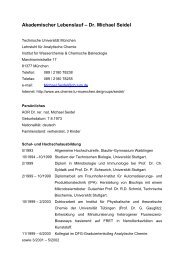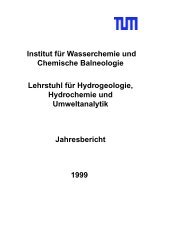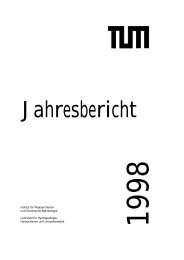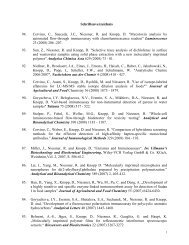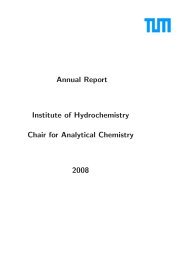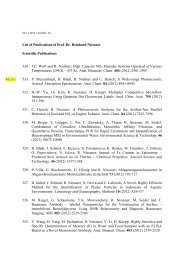IWC Annual Report 2003 - Institut für Wasserchemie und chemische ...
IWC Annual Report 2003 - Institut für Wasserchemie und chemische ...
IWC Annual Report 2003 - Institut für Wasserchemie und chemische ...
You also want an ePaper? Increase the reach of your titles
YUMPU automatically turns print PDFs into web optimized ePapers that Google loves.
8<br />
concentration, mg/L<br />
10<br />
9<br />
8<br />
7<br />
6<br />
5<br />
4<br />
3<br />
2<br />
1<br />
0<br />
-1<br />
1.1.5 In Situ Monitoring for Soil and Water by Infrared Sensing<br />
F<strong>und</strong>ing: EU EVK1-CT-1999-00042<br />
Cooperation: Fraunhofer-<strong>Institut</strong> <strong>für</strong> Physikalische Messtechnik, Freiburg; Technische<br />
Universität, Wien; Universität <strong>für</strong> Bodenkultur, Wien; Tel Aviv University; Université<br />
de Rennes; CSIC, Barcelona<br />
A high latent and real potential of environmental hazards & health implications from<br />
landfills and leakage still remains, since multitudinous of these landfills are presently<br />
not state of the art. This is caused by nonexisting flexible membrane linings, missing<br />
mineral base linings and the lack of seepage collecting & treatment systems. Contrary<br />
to numerous European efforts for the reduction and prevention of waste, the production<br />
still increases. So nearly 60% of domestic and more than 65% of hazardous waste<br />
are still deposited in landfills. Due to this fact, gro<strong>und</strong>- and surface water in the<br />
surro<strong>und</strong>ing of these installations is exposed to the risk of contaminations for a long<br />
time. Consequently the requirements for an continuous control and survey of leakage<br />
and landfill contaminations increased. Abandoned waste sites need to be screened and<br />
monitored for possible release of organic matter, too.<br />
VUT Sensor data (DCB)<br />
GC data (DCB)<br />
0 100 200 300 400 500 600 700<br />
time, min<br />
Within the scope of the IMSIS project (In Situ Monitoring<br />
of Landfill Related Contaminants in Soil and Water by<br />
Infrared Sensing) fibre-optic evanescent wave sensor systems<br />
for the detection of organic pollutants (BTEX, PAH,<br />
etc.) in gro<strong>und</strong>water and seepage are developed.<br />
In this consortium the <strong>Institut</strong>e of Hydrochemistry and<br />
Chemical Balneology at the Technical University of Munich<br />
(<strong>IWC</strong>) provides laboratory and pilot scale facilities<br />
for experiments with the IMSIS sensor systems. Besides<br />
<strong>IWC</strong> selects and offers adapted field test sites for realworld<br />
experiments. For these experiments possible fields<br />
of application are presented and the legal issues for measuring<br />
campaigns settled. <strong>IWC</strong> characterizes the contaminated<br />
sites hydrochemically and hydrogeologically. Besides,<br />
the representativeness of the sensor measurement<br />
data for the total contamination is evaluated.<br />
Respectively the response behaviour of the new developed sensor systems for short<br />
and long term changes is verified. Therefore numerous experiments have been carried<br />
out at the <strong>IWC</strong> pilot scale facilities. In addition, the long term stability of the system<br />
- especially the composition and the effects of organic and inorganic coatings - are<br />
investigated. Particulate appearing H2S from sulfur reducing ambience on landfills,<br />
showed to corrode and destroy the silver halide fibers of the IMSIS-systems. Except<br />
chalcogenide glass fibres from one project partner showed no interference to the H2S.<br />
After a calibration of the detecting unit, it is possible in noncorrosive systems not<br />
only to prove the existence of organic pollutant groups like VOC, BTEX, PAH, phenols<br />
or alike. Rather there is the opportunity to discriminate single substances like<br />
tetrachloroethylene (TCE) or dichlorobenzene (DCB), or to filter the information for<br />
single substances out of the measured spectral data, by using spectral databases. A<br />
real world experiment was performed in contribution with UFZ-SAFIRA pilot plant in<br />
Bitterfeld (Umweltforschungszentrum Halle-Leipzig), Saxony-Anhalt. Different technical<br />
approaches (usual sensor set-up, miniaturized spectrometer), sensor parts (fibres,<br />
coatings, ATR-crystals) and reference methods were tested in these sets of experiments<br />
successfully.



